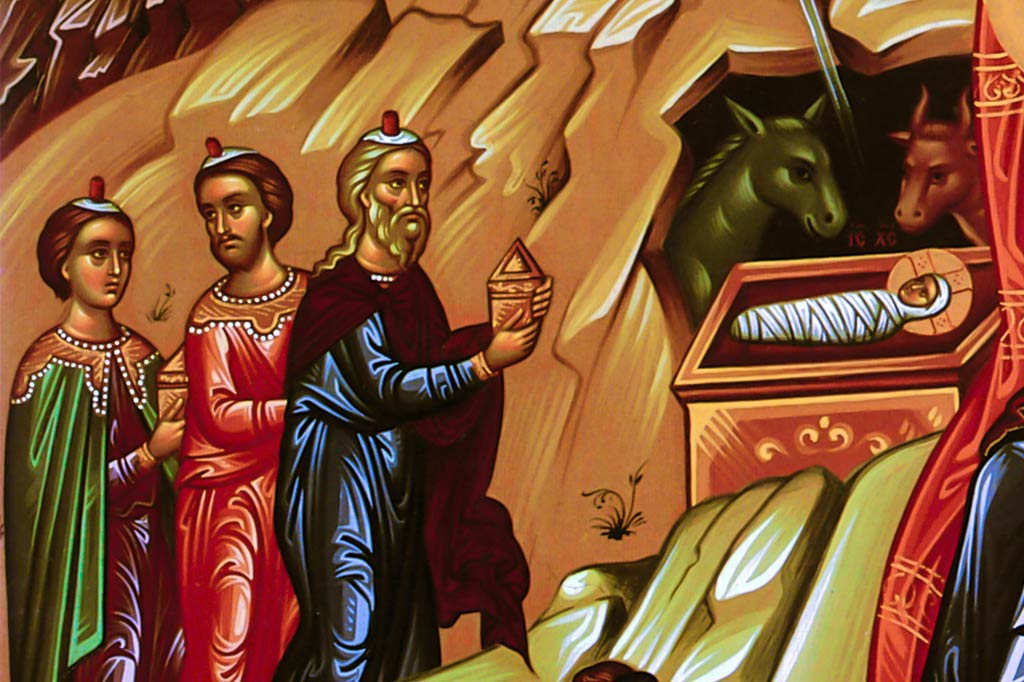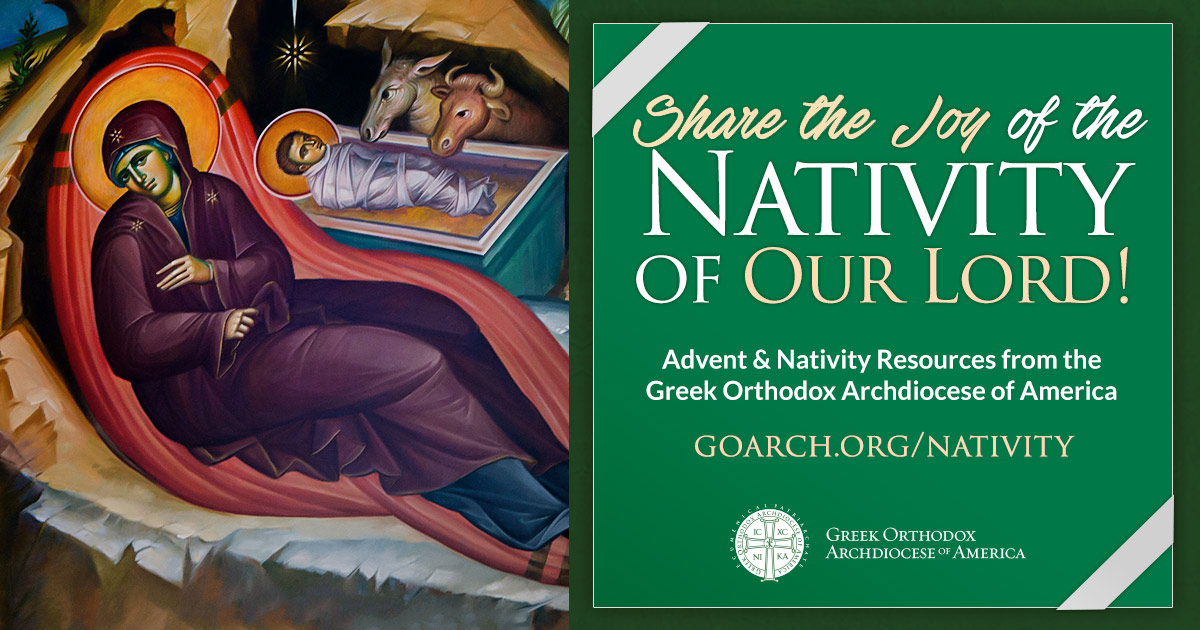Every good story needs a villain—even a Sunday-School Christmas pageant. Of course, the original Christmas story from Matthew and Luke had a super-villain: King Herod. But for a Sunday School production, it doesn't really work to have grade-school kids acting out the Slaughter of the Innocents, so there isn't room for a Herod. In his place, therefore, a new villain must be found. And so now the bad guy of every Christmas pageant is ... the innkeeper! That cruel, heartless, money-driven petty tyrant who couldn't find a space in his inn for a pregnant woman and her weary husband. Because of his indifference, the holy family winds up—not in a room at the Bethlehem Motel Six—but in a barn, in a stable, amidst hay and cattle … and all that stuff that turns up when cattle and hay come together. It is a picture of consummate inhospitality toward the infant Christ.
And it comes straight from the Gospel of Luke, right? "And she gave birth to her first-born son and wrapped him in swaddling clothes and laid him in a manger, because there was no room for them in the inn." But is this what the Gospel means in the original? The problem is that ancient Greek had a word for "inn"—pandocheion. It is similar to the modern Greek word for hotel, xenodocheio. We find this word later in the Gospel of Luke in the parable of the Good Samaritan. The Samaritan brings the wounded Jewish man to an inn, pandocheion, and pays the innkeeper to take care of him. But the word in the Christmas story is not this word.
In chapter 2 of Luke we find another word: katáluma. Katáluma means a place to sleep, usually in the sense of a guest room, a spare room. But not a guest room in an inn, but a guest room in a home. The word katáluma comes up again in the Gospel of Luke in connection with the Last Supper, when Jesus instructs two disciples to ask about a room where he can eat the Passover with his disciples. He tells them to ask for a katáluma.
We think of the Last Supper as taking place in an upper room, a space on the second story of a house. And that is generally an accurate picture of where the guest quarters would be in an ancient home in Judea. The average person's house was nothing more than four walls enclosing a single room with a flat roof. Your bedroom was your living room, which was also your dining room and your den. If there were guests to be accommodated, often the guest room would be set up on the roof of the house. This would be the katáluma. Luke tells us that when the holy family got to Bethlehem, ouk een aftois topos en to katalúmati, "there was no space for them in the guest area."
Whose guest area? The innkeeper's? Highly unlikely! First of all, Bethlehem in the first century was a tiny, tiny village off the main roads. It probably didn't have an inn of its own: there wouldn't have been enough business to keep it open. If you were going to Bethlehem, it was because you knew someone there. And Middle Eastern hospitality meant that you stayed at the home of the person you were visiting-a relative or a friend-in their special guest room, their katáluma. We know that Joseph and Mary had relatives in Bethlehem: that's the whole reason they went there, so that Joseph could return to his familial hometown for the census. It would have been normal and natural that they would stay in the home of a family member. It would have been strange and unexpected for them not to stay with family: it would have been an insult, in fact, one way or the other.
Can you imagine going back to Greece to visit the chorio and not staying with the family? After I finished my undergraduate degree, I went to Europe for a few weeks to see the family’s ancestral homes in Holland and Denmark. I didn't ask my relatives there for a list of local hotels, and they didn't offer me one. I stayed in their homes, in their guest rooms. And if that is the case for Westerners in the 20th century, how much more so for Middle Easterners in the first century?
But, of course, Joseph and Mary were not the only relatives coming back to the old stomping grounds that Christmas. All of Joseph's other relatives who had left Bethlehem would have been required to return. And so it only makes sense that all of the family katalúmata, guest-rooms, would have been full. The slowest to arrive would have found that there was no space in the katáluma for them. And a man traveling from Nazareth way up north down to Bethlehem in the south, with a pregnant wife, would probably have been the last to arrive.
By the way, while we are playing Mythbusters today, we should probably also give up the Christmas pageant idea that Jesus was born just as Joseph and Mary reached Bethlehem, and that everything happened super-fast before there was time to get decent accommodations. The Gospel of Luke says clearly that Mary's labor began after they had arrived (Luke 2:6): "And while they were there, the time came for her to be delivered." No indication that they made it to town just at the last moment before her water broke—quite the opposite. Even so, the houses in town would have been full to bursting already when they arrived.
But would they then have been pointed to the shed to sleep with the cows? No—because there probably wasn't a separate shed for the animals. Just like nowadays, most of us have garages attached to our houses that are on a level a few steps below the floor of the house; back then, the average home had an area—within the four walls of the one-room house!—for the animals to spend the night. Archaeologists have found lots of these simple split-level homes with a dugout area in one end of the house where the animals would be brought in for the night, to keep them warm (and to use their body heat to help keep the whole house warm) and to keep them from being stolen. And so the people slept in one part of the room and just a few feet away and a few steps down, the donkey, the ox, the sheep would have slept as well. And just in case the animals needed a nosh in the middle of the night, oftentimes a feeding trough would be carved into the floor of the higher living area, so the animals could stand and eat hay. This trough was the manger.
Why would you put a new mother and her child down by the animals? Well, first of all, maybe there weren't any animals there at that time. Maybe that part of the house could have been cleaned out for human occupation while the animals were housed overnight with a friend or relative nearby. In that case, then the lower area with the mangers would have been a good place for the baby. It would have had a little more privacy and quietude than the rest of the house. It would have been close enough for help but far away enough for separation.
And so, perhaps, after all, there is no villain on Christmas night. Perhaps there are only average people doing the best they could to help under the circumstances. It's not quite the superhero story of a lone mother and child braving rejection and the elements. It is less dramatic than the last-minute birth scenario we have been accustomed to, but it is also more true to life and true to Luke’s Gospel. The poor people of Bethlehem—and poor they were in that village at that time—they were not the villains of Christmas Eve.
But in a sense, that's the point. When Christ came to the poor and the powerless, they received Him. They were not the ones who rejected him. It was the rich and powerful, the high and mighty, the best and the brightest, the movers and shakers-these were the ones who would prefer to see Christ left out in the cold. But the common people received him gladly, during His ministry and from the moment of His Incarnation. And so it is still today. Blessed are the poor—and the poor in spirit—for theirs is the Kingdom of Heaven. This is the message of Christ and the message of the Christmas story.
*Fr. Mark Sietsema is the Presiding Priest at the Holy Trinity Greek Orthodox Church in Lansing, MI

